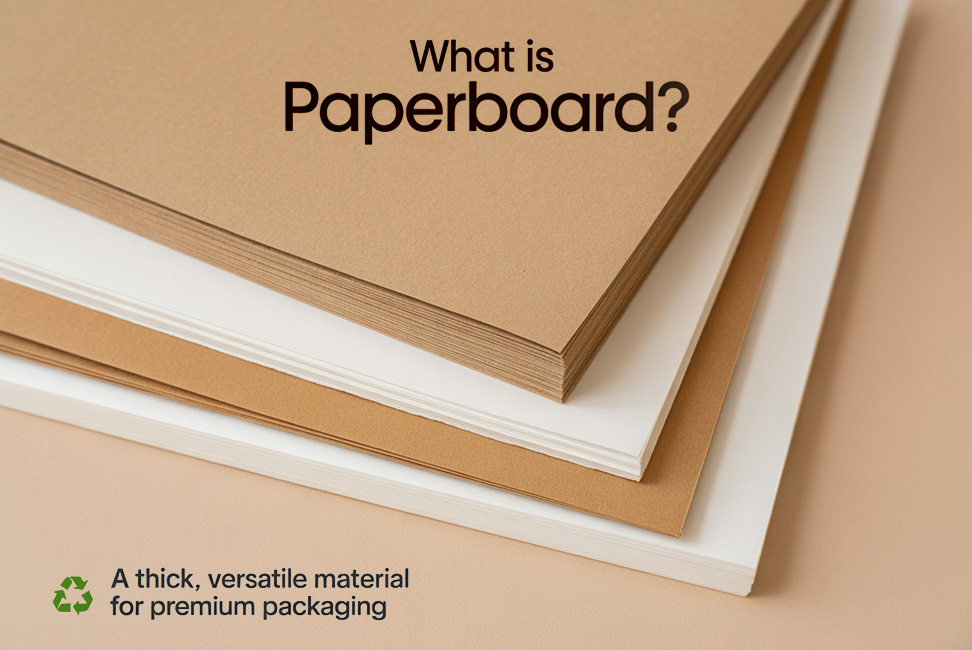- Home
-
By Industry
- Custom Retail Boxes
- Custom Cardboard Boxes
- Custom Cosmetic Boxes
- Custom Food Boxes
- Custom Gift Boxes
- Custom Display Packaging
- Custom Mailer Boxes
- Custom Paper Bags
- Custom Sports Boxes
- Custom Stationery Boxes
- Custom Bakery Boxes
- Custom CBD Boxes
- Custom Vape Boxes
- Custom Gable Boxes
- Custom Tuck Boxes
- Custom Pillow Boxes
- Custom Cupcake Boxes
- Box by Style
- Custom Packaging
- Our Products
- Request Quote
What is Paperboard?

Paperboard is a thick, paper-based packaging material made from compressed layers of wood pulp, typically above 250 gsm, known for its rigidity and durability.
It is used in packaging due to its strength, printability, and recyclability.
What is Paperboard Packaging?
Paperboard packaging is famous because of its sturdiness and durability. It has a smooth surface, and it can be used for packaging various products. This material is also known as carton board. Its thickness and stiff nature make it different from cardboard.
4 Types of Paperboard
Paperboard comes in many types, made from different fibers and coatings for various packaging needs. Each type of paperboard is made to meet specific needs for strength, appearance, and eco-friendliness. Choosing the right paperboard depends on the product’s weight, appearance, moisture resistance, and printing requirements.
Below is a detailed explanation of each type of paperboard:
1. Solid Bleached Sulfate (SBS)
Solid Bleached Sulfate, commonly referred to as SBS board, is manufactured using 100% virgin bleached wood pulp, giving it a pure white color and exceptionally smooth surface.
This board is fully bleached during production to ensure consistency, brightness, and high print receptivity.
It is one of the most luxurious types of paperboard. It has a smooth and clean surface. Moreover, it’s quite famous for its bright color. It also offers durable printing results. One of the most common reasons is that brand MS chose this grade because of its pristine look. It is available in white. The white color makes the packaging look regal and premium. It has no toxins used in its making. Additionally, it’s highly durable as well as food-safe.
Application:
Some of the common uses of SBS include skincare boxes, cosmetic boxes, perfume boxes, and watch boxes. Solid bleached sulfate can be used for all types of retail and e-commerce products.
Must Read: Types of Boxes
2. Coated Recycled Board (CRB)
The Coated Recycled Board (CRB), sometimes known as White Lined Chipboard (WLC), is made primarily from recycled paper and post-consumer waste fibers. It is coated, usually with a layer of clay, to enhance its print surface and provide a smoother appearance.
CRB is the most cost-effective and sustainable paperboard. It uses a lot of recycled materials, reducing the need for virgin pulp. CRB is commonly used for dry food packaging, shoe boxes, household goods, and detergent cartons. It is chosen when visual appeal matters more than high strength or moisture resistance.
While CRB does not have the same brightness or smoothness as SBS, it performs adequately in most consumer packaging scenarios. Its main benefits are sustainability and low cost, making it ideal for large-scale packaging.
However, because it is made from recycled fibers, CRB generally has lower strength and stiffness compared to virgin-fiber boards. It is not suitable for packaging that requires direct food contact without an inner liner.
3. Folding Boxboard (FBB)
Folding Boxboard (FBB) is a multi-ply structure that combines the best attributes of strength, lightness, and visual quality. It is made from layers of mechanical pulp in the middle, sandwiched between chemical pulp layers on the top and bottom surfaces. The outer layer is usually bleached to provide a clean, printable surface, while the inner layer provides bulk and stiffness.
It is strong yet lightweight, offering excellent stiffness without extra material, making it ideal for sustainable packaging. FBB’s lightweight nature also reduces transportation costs and carbon footprint.
FBB is used for food packaging like chocolates, snacks, and frozen items, as well as healthcare, cosmetics, and personal care products. It has a clean, white surface that prints well. It folds, creases, and glues easily without cracking. FBB combines mechanical and chemical pulps, giving a good balance of cost and performance. It is popular in Europe, where lightweight and sustainable materials are preferred.
4. Unbleached Kraft Board (CUK)
The Unbleached Kraft Board is produced from 100% virgin kraft fibers that are not bleached, giving the material its characteristic natural brown color. It is known for its exceptional strength, durability, and resistance to moisture, making it suitable for heavy-duty packaging applications.
This type is made from unbleached Kraft fibers. It is mostly available in brown. But the external surface can be printed with any color. It offers a high-quality look to your product packaging. The use of high-end finishes on this paperboard makes it perfect for branding. Additionally, this material is also moisture-resistant, which makes it safe for your products.
In recent years, the earthy, natural appearance of kraft board has also gained popularity in eco-friendly and organic product packaging. Brands use their rustic aesthetic to communicate environmental authenticity and sustainability.
While CUK offers excellent durability, its brown surface is less suitable for high-quality color printing. For this reason, some CUK boards are coated on one side to provide a white surface for printing while retaining kraft strength on the reverse.
Also ReadL: Difference Between Kraft Paper and Normal Paper
High-End Benefits of Paperboard Packaging
Paperboard packaging has become the preferred choice for both premium and everyday products. Beyond being a simple container, it serves as a powerful marketing tool that communicates brand value, protects products effectively, and aligns with modern sustainability goals. Below are the key high-end benefits of paperboard packaging explained in detail:
1. Premium Print Quality and Visual Appeal
One of the most notable advantages of paperboard packaging is its exceptional printability. The smooth, uniform surface of paperboard allows for high-resolution graphics, intricate designs, and vibrant colors.
Brands use advanced printing techniques such as offset, digital, and flexographic printing, along with finishing effects like embossing, foil stamping, UV coating, and matte lamination to create packaging that looks elegant and luxurious.
This superior print quality makes paperboard the ideal choice for cosmetics, electronics, perfumes, and gourmet foods, where packaging plays a major role in influencing purchasing decisions. It not only protects the product but also serves as a brand ambassador on the shelf, enhancing consumer perception and trust.
2. Sustainable and Eco-Friendly Material
Paperboard is a flexible material. Its composition makes it eco-friendly. This eco-friendly appeal is an excellent factor that can help you attract your customers. The majority of consumers like to buy from brands that promote sustainability. Therefore, the use of paperboard for your products can prove to be in your favor.
Furthermore, paperboard packaging can be personalized however you want. You can choose the size, style, and shape of this material according to your product requirements.
3. Lightweight Yet Strong Structure
Despite being lightweight, paperboard provides excellent structural strength and rigidity. It can support a wide range of products, from lightweight cosmetics to heavy beverage multipacks.
This combination of strength and lightness makes it cost-efficient to transport and store. In e-commerce, where packaging weight directly affects shipping fees, paperboard offers an unbeatable balance between protection and efficiency.
4. Exceptional Versatility in Design and Function
Paperboard’s flexibility allows it to be molded, folded, die-cut, laminated, or coated to fit virtually any packaging need. It can be transformed into folding cartons, rigid boxes, sleeves, trays, or inserts, and adapted with functional coatings for moisture or grease resistance.
Paperboard works for food, pharmaceuticals, electronics, and luxury goods. It offers both protection and design flexibility. Brands can utilize various shapes, textures, and openings to create packaging that is both memorable and distinctive.
5. Consumer Appeal and Brand Differentiation
In retail, packaging is often the first interaction a consumer has with a product. Paperboard’s premium look and tactile quality create a sense of trust and sophistication.
Its clean lines, smooth finishes, and customizable printing make it ideal for luxury and high-end markets. Moreover, eco-conscious consumers are increasingly favoring products that utilize recyclable or compostable packaging.
6. Barrier Coating and Product Protection
Modern paperboard packaging can be enhanced with advanced coatings, including water-based, bio-based, or polymer barriers, to resist moisture, oil, and oxygen.
These innovations have made paperboard suitable even for frozen foods, beverages, and greasy snacks, which traditionally relied on plastic packaging. The result is packaging that combines protection, sustainability, and visual excellence in one material.
7. Cost-Effective and Efficient Production
From a manufacturing standpoint, paperboard offers excellent cost efficiency due to its wide availability and adaptability to high-speed printing and converting processes.
Its ease of cutting, folding, and gluing streamlines production lines, while its compatibility with automated packaging machinery ensures consistency and precision. For brands, this means lower production costs, faster turnaround, and reduced material waste — without compromising on appearance or performance.
8. Enhances Brand Storytelling and Experience
Today’s consumers value brands that tell a story. Paperboard packaging provides a canvas for storytelling, allowing companies to communicate their sustainability values, craftsmanship, or product origins directly through design.
Paperboard’s texture and look make the unboxing experience better, especially for premium and online brands. This emotional connection helps create lasting impressions and brand recall.
Conclusion
Paperboard is a versatile, durable, and eco-friendly packaging material widely used across industries. Paperboard is strong, easy to print on, and eco-friendly, making it great for protecting products and boosting brand appeal. Knowing its types helps businesses pick packaging that is functional, attractive, and sustainable.
Frequently Asked Questions
1. What is paperboard packaging?
Paperboard packaging is made from thick, durable paper-based material used to create boxes, cartons, and containers for various products.
2. What is paperboard printing?
Paperboard printing refers to applying designs, text, and graphics onto paperboard surfaces using methods like offset, flexographic, or digital printing.
3. Paperboard examples
Examples include cereal boxes, cosmetic cartons, shoe boxes, and pharmaceutical packaging.
4. What is paperboard made of?
Paperboard is made from compressed wood pulp fibers, either virgin (from trees) or recycled paper fibers.
5. Paperboard vs cardboard
Paperboard is a thinner sheet used for product packaging, while cardboard is thicker and often layered, used for shipping boxes.
6. Paperboard packaging Examples
Examples include toothpaste boxes, frozen food cartons, perfume boxes, and medicine packaging.
Jeff parker is a seasoned packaging industry writer with over 6 years of experience specializing in innovative custom packaging solutions. Based in New York, Parker combines hands-on knowledge from his early career in printing technology with a deep understanding of packaging trends across sectors like cosmetics, food, tobacco, and retail. Passionate about helping businesses enhance their brand presence through effective packaging, he regularly shares insights on the latest industry innovations.
